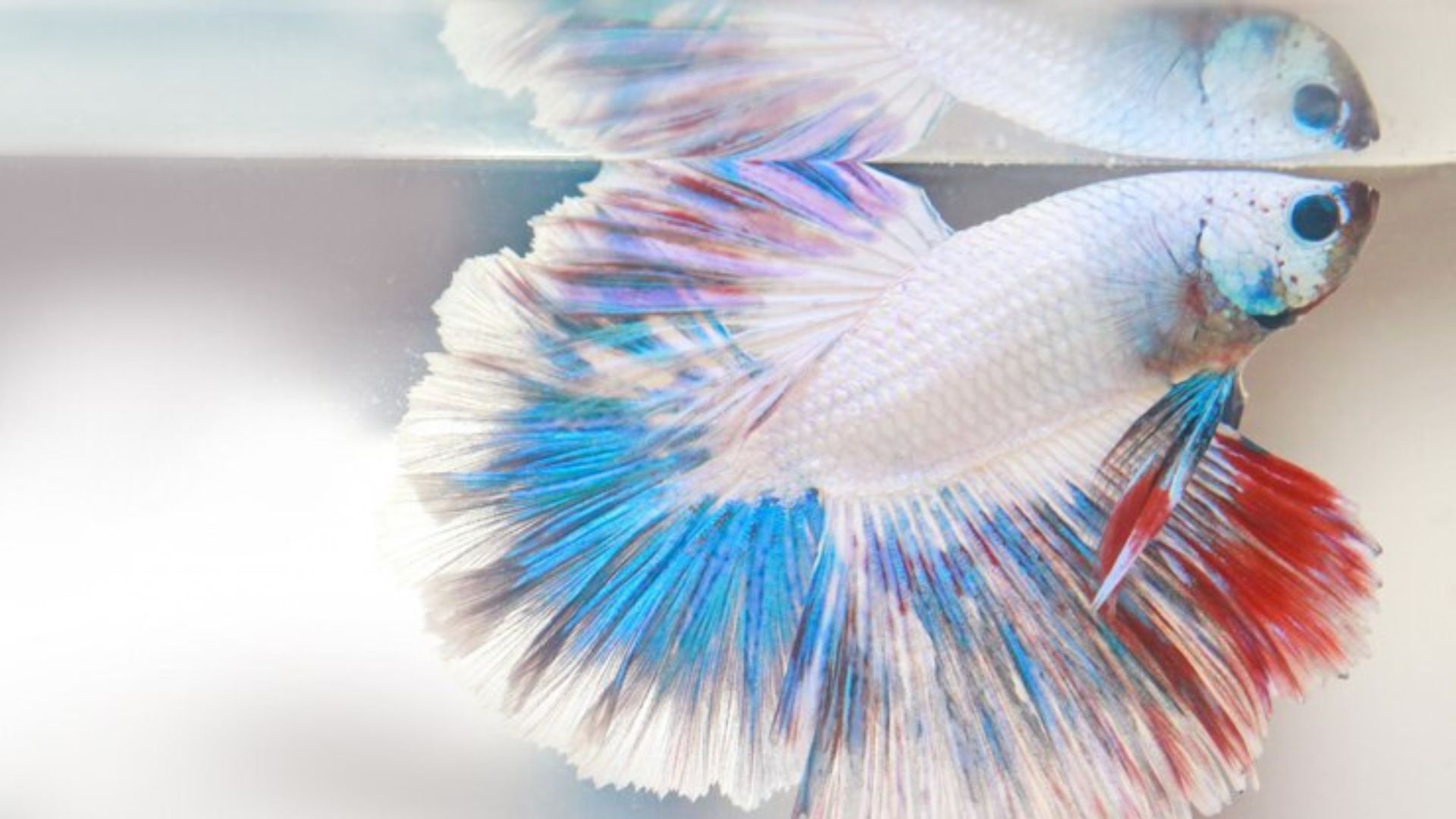The White Betta Fish, also known as Betta splendens, is a popular species in the aquarium hobby due to its vibrant colors, aggressive personality, and captivating appearance. While Betta fish are often seen in a variety of colors, the white variety is particularly prized for its elegant and pure look. These fish make a striking addition to any aquarium, whether you’re an experienced aquarist or a beginner looking to care for a beautiful aquatic companion.
In this article, we will explore all aspects of White Betta Fish, including their appearance, ideal care conditions, and the best practices for maintaining a healthy tank. Additionally, we will answer some common questions to help you become a more informed Betta keeper.
Appearance of White Betta Fish
White Betta Fish are a variation of the Betta splendens species. Unlike other Betta fish that come in various shades of red, blue, green, and purple, the white Betta is marked by its snow-white body, which can sometimes appear translucent under certain lighting. They may have hints of other colors, such as pastel blues, pinks, or purples, especially along their fins or tail. The quality of the white coloration can vary, with some Bettas showing a more silvery-white sheen while others are a deeper, opaque white.
The fins of a White Betta are often long and flowing, which is one of the most admired features of the species. These fish can have a variety of fin types, including:
- Veil Tail: Long, flowing fins that form a “veil-like” appearance.
- Crown Tail: The fins are spiked with long, pointed edges.
- Halfmoon Tail: A symmetrical tail with a full 180-degree spread.
- Plakat: A shorter fin variety that is closer to their wild ancestors.
A White Betta can be both captivating and graceful in an aquarium, especially if you have the right lighting to highlight its sleek, almost ethereal presence.
The Personality of White Betta Fish
Like all Betta fish, White Bettas are known for their strong and independent personalities. They are often referred to as “Siamese fighting fish” because of their territorial nature and tendency to become aggressive towards other males. Bettas can also be quite reactive to their surroundings and owners, often recognizing their caretakers and even following their finger movements. Despite their aggressive streak, they can be kept peacefully with certain tank mates and under the right conditions.
White Betta Fish are typically more tolerant of their own reflection and may be less stressed out by seeing themselves in the glass, unlike some of the more colorful Betta varieties that tend to flare up more frequently. However, it’s still best to keep them alone in a tank, as they tend to thrive in solitude.
The Ideal Tank Environment for White Betta Fish
Creating the right environment for your White Betta is crucial to its overall health and happiness. Bettas are native to the shallow, slow-moving waters of Southeast Asia, so replicating this habitat in your aquarium will help your fish feel more at home.
Tank Size
The minimum tank size for a White Betta Fish is 5 gallons, but bigger is always better. Bettas can be territorial, and a larger tank offers them enough space to swim freely without feeling confined. It’s important to note that Bettas should never be kept in a small bowl, as they need proper water filtration and space to swim around.
Water Parameters
Bettas prefer warm water, with a temperature range between 76°F and 82°F (24°C – 28°C). You’ll need to use a heater to maintain consistent warmth in the tank, especially in cooler climates. The water should be soft to moderately hard with a pH range between 6.5 and 7.5.
Frequent water changes are necessary to maintain a clean environment. At least a 25% water change should be done weekly to prevent the build-up of toxins like ammonia and nitrate, which can harm your Betta.
Filtration and Aeration
While Betta fish are known to thrive in still waters in the wild, it’s important to use a gentle filtration system in their aquarium to keep the water clean. Bettas have labyrinth organs that allow them to breathe surface air, so strong water currents should be avoided as they can stress out your fish.
A sponge filter or a low-flow filter works well for White Betta Fish. Ensure the filter’s output doesn’t create excessive water movement, as this could be uncomfortable for your Betta.
Tank Decorations
White Bettas are naturally drawn to plants and soft, non-sharp decorations that they can explore. Live plants, like Java moss, Amazon swords, or Anubias, can offer hiding places and help keep the water clean. Be sure to avoid decorations with rough edges that could tear your Betta’s delicate fins.
You can also provide hiding spots using smooth, rounded objects or caves. However, it’s essential to keep the tank spacious enough for your Betta to swim freely.
Feeding White Betta Fish
White Betta Fish are carnivorous, and they thrive on a diet rich in protein. In the wild, they feed on small insects and larvae, but in an aquarium, you can offer them high-quality Betta pellets, frozen or live food like brine shrimp, daphnia, and bloodworms.
Feed your Betta 1-2 times a day, offering an amount that they can consume in 2-3 minutes. Overfeeding can lead to water quality problems and health issues such as obesity and constipation. It’s also a good idea to provide a variety of foods to ensure your Betta gets all the necessary nutrients.
Common Health Problems in White Betta Fish
While Betta fish are generally hardy, they are prone to a few health issues, especially if not provided with the right care. Here are some common problems that may affect your White Betta Fish:
Fin Rot: This condition occurs when the fins of the Betta begin to deteriorate due to bacterial infection. It is caused by poor water quality or injuries. To prevent fin rot, maintain clean water and remove any sharp objects from the tank.
Ich (White Spot Disease): Ich is a common parasitic infection that causes white spots to appear on the skin, fins, and gills. It can be treated with medication and by raising the temperature of the tank.
Swim Bladder Disorder: Bettas may experience swim bladder issues, which affect their buoyancy. This condition can be caused by overfeeding or constipation. Fasting your Betta for a day or two may help alleviate mild cases.
Velvet Disease: A protozoan parasite causes this condition, which leads to a gold or rust-colored sheen on the Betta’s body. It can be treated with copper-based medications.
Conclusion
White Betta Fish are an incredible addition to any aquarium, with their unique appearance and engaging personalities. To ensure they thrive, it’s essential to provide them with the right tank setup, maintain proper water conditions, and offer a nutritious diet. Regular monitoring of their health and behavior is crucial to keeping them happy and vibrant.
ALSO READ:Choose Your Hard: Embrace the Challenges for Growth
FAQs
Can White Betta Fish live with other fish?
White Betta Fish, like other Betta fish, are territorial and may become aggressive towards other fish, especially males. It’s best to keep them alone or with peaceful, non-aggressive species, preferably in a tank with plenty of hiding spots.
How often should I change the water in my White Betta Fish’s tank?
You should aim to change 25% of the water in the tank every week to keep the water clean and maintain good water quality.
What is the lifespan of a White Betta Fish?
With proper care, a White Betta Fish can live for 2 to 3 years. Some Betta fish have been known to live even longer with optimal conditions.
Do White Betta Fish need a filter?
While Bettas can survive without a filter, it is highly recommended to use a filter to keep the water clean. However, make sure the filter has a gentle flow to avoid stressing your Betta.
Can I feed my White Betta Fish vegetables?
Betta fish are carnivorous and should primarily be fed a protein-based diet, such as high-quality pellets, frozen or live foods like brine shrimp, and bloodworms. They do not typically eat vegetables.
How can I tell if my White Betta Fish is sick?
Signs of illness in Betta fish include lethargy, loss of appetite, abnormal swimming, discoloration, and visible lesions or fins that appear ragged. Regularly monitoring their behavior and health will help you catch any issues early.







